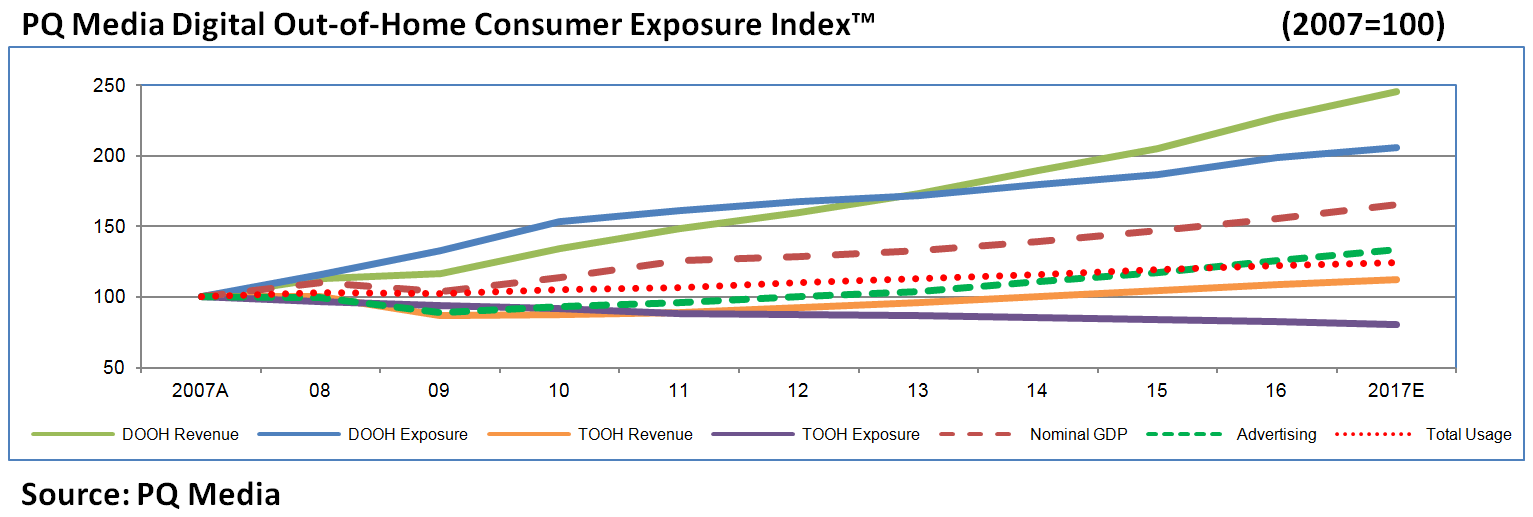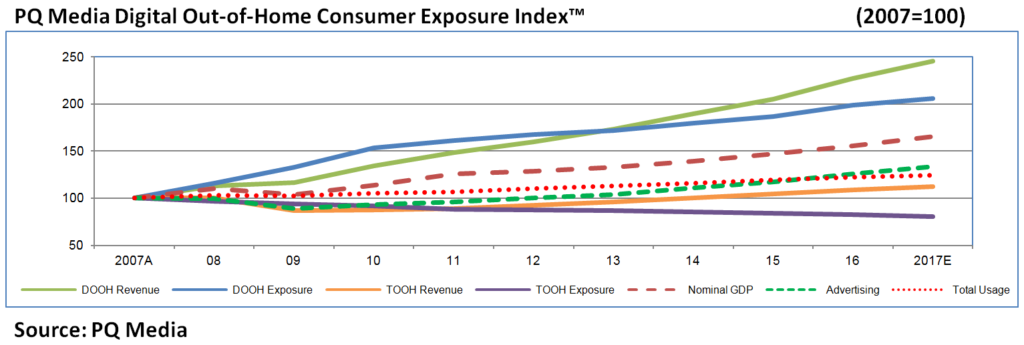
Research Pegs Digital Out Of Home As World’s 2nd Fastest Growing Medium
February 27, 2014 by Dave Haynes

PQ Media has pushed out new global market research that suggests digital OOH media “may be on the cusp” of its big breakout phase.
The research firm suggests digital signage is “now the world’s second fastest-growing ad medium, and it is quickly becoming a vital component of the transitioning media ecosystem.”
(Note: even the company that caters, sells and bills to that space doesn’t even call it digital place-based.)
PQ Media’s new Consumer Exposure to Digital Out-of-Home Media Worldwide 2014 suggests the average global consumer was exposed to various DOOH media for 14 minutes per week in 2013, a 75% increase from only eight minutes in 2007.
Key growth drivers included:
- consumers spending a record amount of time with media outside their homes;
- increased engagement during the day with corresponding content on DOOH screens that are linked to wireless devices;
- longer work commutes;
- and consistent growth in leisure travel and shopping hours.
In addition, PQ Media’s data indicates that improved designs, content, interactivity and mobile couponing are extending dwell time with screens. Collectively, these trends factored into the deployment of thousands of new digital signage networks in the 2007-13 period in the Top 15 Global DOOH Markets, concentrated in high-traffic, captive and measurable locations, such as roadside, healthcare and transit.
PQ Media’s Consumer Exposure to Digital Out-of-Home Media Worldwide 2014 delivers the first in-depth, cross-channel datasets, time series and analytics developed with a proven media consumption methodology applied consistently to each country for the 2007-17 period. Adding value to its methodology, PQ Media created the Consumer DOOH Exposure Index™ to compare exposure growth with that of operator revenues and other ad-based media.
The exposure index showed that global consumers are spending more time outdoors, dedicating substantial amounts of time to activities placing them near digital billboards and video networks. Accordingly, DOOH media is the second fastest-growing ad medium worldwide based on average weekly consumer exposure projected through 2017.
DOOH trailed only mobile media in 12 of the 15 largest markets where exposure results were also compared with seven other ad media, including traditional OOH, television, radio, newspapers, magazines, internet and mobile. Comparison ad media data were gleaned from PQ Media’s Global Consumer Usage of Digital Media Forecast 2013-17.
In a prescient sign for DOOH, PQ Media’s approach yielded outcomes similar to those published in the aforementioned consumer media usage report, which hypothesized that end-user spending on digital media drives growth in consumer media usage, which leads to increased ad spend on digital media.
Specifically, the exposure index revealed that the strongest DOOH markets produced rapid exposure growth in the historical period (2007-12), as more digital signage was deployed. With DOOH market leaders emerging in major metros worldwide, however, the index shows that operator revenues in these markets have begun to grow faster than consumer exposure, as advertisers up their DOOH budgets to engage more elusive consumers by purchasing avails in captive venues offering longer dwell times.
“DOOH exposure and revenues continue to grow at a time when ad media are increasingly challenged by cross-currents taxing their ability to engage target consumers,” said Patrick Quinn, CEO, PQ Media. “Projected higher gains in DOOH revenue compared with lower growth of consumer exposure in the 2013-17 period, a trend that often indicates longer-term success for emerging media.”
Consumer DOOH exposure is forecast to increase at a compound annual growth rate (CAGR) of 8.6% to 20 minutes on average per week in 2017, fueling higher spending on DOOH inventory and a 14.2% CAGR in operator revenues in the forecast period.
Traditional OOH revenues, meanwhile, will rise at a 4.1% CAGR over the next five years, as static billboards decline at a 1.6% CAGR to 44 minutes weekly in 2017.
Key growth drivers will include steady rollouts of dynamic signage to replace lower-margin traditional displays in choice metros, improved content, stronger measurement and tactics geared to boost engagement via links between DOOH messages and mobile and social media.
Key Takeaways: Top 15 Global Markets
While the US remains the world’s largest DOOH market by revenues, it ranks fourth in consumer DOOH exposure behind Australia, the UK and Canada, all of which have high concentrations of people near a few major cities where most DOOH engagement occurs. US exposure still increased nearly 20 minutes on average weekly to 47 minutes in 2013. Traditional OOH exposure averaged one hour more than DOOH, but declined 24 minutes since 2007. DOOH exposure will average 56 minutes per week in 2017.
Bolstered by the successful results during the UK-hosted Summer Olympics in 2012 and high expectations for the 2016 summer games in Brazil, DOOH exposure is projected to exceed that of traditional OOH in both countries in 2017. Key drivers will include innovative uses of new technologies, more interactive content and DOOH placement in the highest-traffic locations. Nearly 50% of the UK’s digital signage is positioned at the busiest sites in London, offsetting exposure time from infinitely more static billboards nationwide.
While China is the second-largest DOOH market by revenues, it features wide swaths of land where digital and wireless technology can’t be deployed yet, either due to regional topography or areas where inhabitants are too far from major cities or not trained to use new technologies. Consequently, Asia’s emerging economic giant has a huge population off the radar, which places China near the bottom of the world’s leading markets.
In 2013, Australia became the first global market in which consumers were exposed to DOOH for more than one hour per week, fueled by a surging digital signage industry in a country where 90% of the population lives near the largest cities and most of the DOOH media. Total OOH revenues here grew 15 of 16 quarters through the end of 2013 and the key driver was DOOH expansion.
The full report will cost you just shy of $1K.



Leave a comment